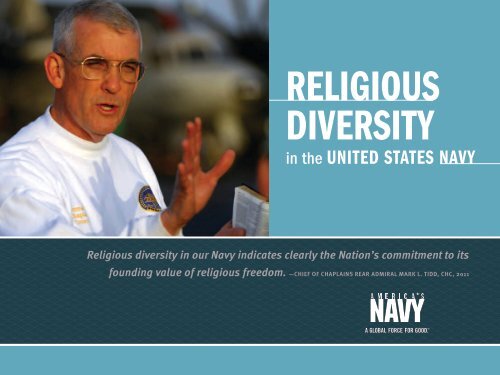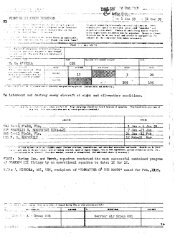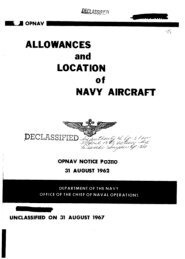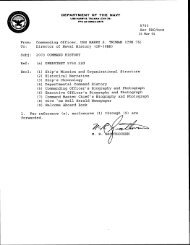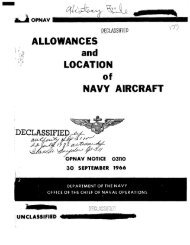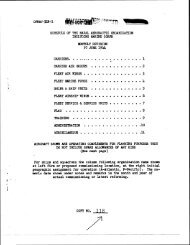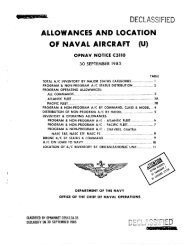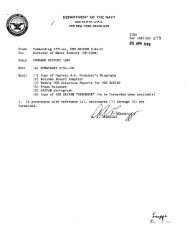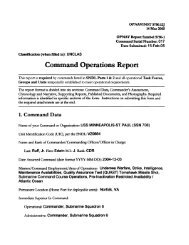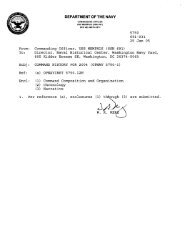religious diversity - Naval History and Heritage Command - U.S. Navy
religious diversity - Naval History and Heritage Command - U.S. Navy
religious diversity - Naval History and Heritage Command - U.S. Navy
You also want an ePaper? Increase the reach of your titles
YUMPU automatically turns print PDFs into web optimized ePapers that Google loves.
eligious<br />
<strong>diversity</strong><br />
in the united states navy<br />
Religious <strong>diversity</strong> in our <strong>Navy</strong> indicates clearly the Nation’s commitment to its<br />
founding value of <strong>religious</strong> freedom. —Chief of Chaplains Rear Admiral Mark L. Tidd, ChC, 2011<br />
A GLOBAL FORCE FOR GOOD.
The <strong>Navy</strong>’s leadership values all aspects of <strong>diversity</strong>, including <strong>religious</strong><br />
<strong>diversity</strong>, fostering an environment in which each individual prospers <strong>and</strong><br />
contributes to the mission.<br />
For both officers <strong>and</strong> enlisted personnel, embracing<br />
the <strong>diversity</strong> within their ranks enhances individual<br />
performance, unit cohesion, <strong>and</strong> combat readiness.<br />
Likewise, the <strong>Navy</strong> Department respects the practice<br />
of religion among its Sailors <strong>and</strong> Marines, believing<br />
spiritual health is as critical to completing the mission<br />
as mental <strong>and</strong> physical fitness for duty. <strong>Navy</strong> chaplains,<br />
Opposite page: Marines <strong>and</strong> Sailors attend <strong>religious</strong> services at a forward<br />
operating base in Afghanistan, December 2001.<br />
Left: Rear Adm. Joseph David Stinson, Deputy Chief of Chaplains for Reserve<br />
Matters <strong>and</strong> Director of Religious Programs, Marine Forces Reserve, greets a<br />
patient at L<strong>and</strong>stuhl Regional Medical Center, Germany, April 2010.<br />
1
who represent nearly one hundred denominations <strong>and</strong><br />
faith groups, tend to the spiritual, physical, <strong>and</strong> emotional<br />
welfare of service members, including those who declare<br />
no <strong>religious</strong> affiliation. <strong>Navy</strong> chaplains are available to all<br />
Sailors <strong>and</strong> Marines regardless of their faith, creed, or<br />
beliefs, strengthening the personal <strong>and</strong> professional lives<br />
of those in need.<br />
The <strong>Navy</strong> accommodates people of faith in various<br />
ways. Its policy, which follows Department of Defense<br />
guidelines, calls for meeting as much as possible the<br />
requirements for <strong>religious</strong> observances, dietary needs,<br />
medical practices, <strong>and</strong> <strong>religious</strong> apparel. While<br />
accommodations <strong>and</strong> signs of respect for <strong>religious</strong><br />
traditions are a part of service life, the requirements<br />
for maintaining military readiness <strong>and</strong> completing the<br />
<strong>Navy</strong>’s operational missions remain the first priority.<br />
<strong>Navy</strong> men <strong>and</strong> women are encouraged to share<br />
their faith without proselytizing. Jewish Sailors extend<br />
open invitations to Seder meals, for example. Audiences<br />
listen to Native American prayers during November<br />
observances honoring American Indian <strong>and</strong> Alaska<br />
Left: A Jewish chaplain conducts services on the aircraft carrier USS<br />
Abraham Lincoln (CVN 72), November 2002. Chaplains of all faiths<br />
serve aboard ships around the world, bringing counseling <strong>and</strong> spiritual<br />
sustenance to Sailors at sea.<br />
Above: A musical ensemble performs during a Protestant liturgy aboard<br />
the aircraft carrier USS Nimitz (CVN 68), July 2009. Shipboard ministries<br />
host three different <strong>religious</strong> services in the ship’s forecastle every Sunday.<br />
Below: Crew members read from the Passover Haggadah (prayer book)<br />
during the Passover Seder meal on board USS Nimitz deployed to the<br />
Arabian Gulf, April 2003.<br />
2
Margaret G. Kibben<br />
A graduate of Goucher College in Towson, Maryl<strong>and</strong>, Rear Admiral<br />
Margaret Kibben holds master of divinity <strong>and</strong> doctorate of ministry<br />
degrees from Princeton Theological Seminary, Princeton, New<br />
Jersey, as well as a master’s degree in national security <strong>and</strong><br />
strategic studies from the <strong>Naval</strong> War College. This Warrington,<br />
Pennsylvania native entered active duty in the <strong>Navy</strong> in 1986 <strong>and</strong><br />
has served with Sailors, Soldiers, <strong>and</strong> Marines around the world.<br />
In 1989 the <strong>Navy</strong> assigned her to the U.S. <strong>Naval</strong> Academy in<br />
Annapolis, Maryl<strong>and</strong>, making her the first female chaplain to serve<br />
there. As an individual augmentee, she completed a deployment<br />
as the Comm<strong>and</strong> Chaplain with the Combined Forces Afghanistan<br />
in 2006. She became the first female chaplain promoted to flag<br />
rank when she was named Deputy Chief of Chaplains <strong>and</strong> the<br />
18th Chaplain of the Marine Corps on 9 July 2010.<br />
“The opportunity to serve Sailors <strong>and</strong><br />
Marines has been one of the greatest gifts<br />
God has provided me.”<br />
Rear Adm. Margaret G. Kibben, Deputy Chief of Chaplains <strong>and</strong> Chaplain of the<br />
Marine Corps, 2010.<br />
3<br />
3
Native heritage. And Sailors may incorporate <strong>religious</strong><br />
culture (through music, scripture, poetry, or other<br />
reflections) in such celebrations as retirements,<br />
promotions, awards, <strong>and</strong> changes of comm<strong>and</strong>.<br />
The service also allows leave for special holy days<br />
<strong>and</strong> pilgrimages. In 2008, for example, the <strong>Navy</strong> afforded<br />
a group of Muslim Sailors the opportunity to make the<br />
Hajj, the pilgrimage to Mecca required at least once in a<br />
lifetime of all financially <strong>and</strong> physically capable believers.<br />
The <strong>Navy</strong> set up the travel arrangements in partnership<br />
with the Kingdom of Saudi Arabia. Lieutenant (j.g.) Rami<br />
H. Islam, the electrical officer aboard the aircraft carrier<br />
Top: Members of the Honor Guard aboard the aircraft carrier USS Theodore<br />
Roosevelt (CVN 71) bow their heads in prayer during a burial at sea,<br />
February 2009.<br />
Center: Chaplain Lt. Jason Gregory reads a Bible on the weather deck of<br />
the guided missile cruiser USS Bunker Hill (CG 52) operating with the U.S.<br />
Southern Comm<strong>and</strong>, March 2010.<br />
Bottom left: Yeoman 3rd Class Douglas Pomeroy, assigned to the amphibious<br />
transport dock USS Nashville (LPD 13), bows in prayer at the Western Wall<br />
in Jerusalem, June 2008.<br />
Bottom right: Cmdr. Dave Adams, comm<strong>and</strong>er of the Khost Provincial Reconstruction<br />
Team, offers a prayer alongside his Afghan partners commemorating<br />
the first water distribution system in the province, December 2007.<br />
4
Abuhena M. Saifulislam<br />
Lieutenant Comm<strong>and</strong>er Abuhena Saifulislam, a native of Bangladesh,<br />
immigrated to the United States in 1989 with a master’s degree in<br />
commerce <strong>and</strong> the ability to speak several languages. He enlisted<br />
in the <strong>Navy</strong> as a payroll clerk in 1992 <strong>and</strong> became a naturalized<br />
citizen in 1995. Four years later he received his commission <strong>and</strong><br />
became the second Muslim chaplain in the <strong>Navy</strong> <strong>and</strong> the first<br />
Muslim chaplain assigned to the Marine Corps. He served at Camp<br />
Pendleton, California; at Guantanamo Bay, Cuba; <strong>and</strong> at the Marine<br />
Corps Base Quantico, Virginia, where he led the effort to establish<br />
the permanent Islamic prayer facility that opened in 2006. President<br />
George W. Bush invited him to lead the call to prayer at the White<br />
House for Ramadan in 2007.<br />
“Many of the world’s troubles today seem to be<br />
caused by cultural misunderst<strong>and</strong>ings. The world<br />
is becoming so small. It is not a choice that we<br />
learn how to live together—it is a necessity.”<br />
Lt. Cmdr. Abuhena M. Saifulislam, ChC, April 2010.<br />
5
Far left: William Balch, the first chaplain known<br />
to have received a commission in the U.S. <strong>Navy</strong>,<br />
served from 1799 to 1801. Painting by Clayton<br />
Braun, c. 1940.<br />
Left: “Assembling the Fleet at Key West—Sunday<br />
Service on the Battleship Texas” by artist H. C.<br />
Christy, 1898.<br />
USS Carl Vinson (CVN 70), who went on the Hajj, noted,<br />
“American Muslims in uniform have fought side by side<br />
to defend the U.S. Constitution since the Civil War. The<br />
<strong>Navy</strong>’s recognition of a faith practiced by a minority<br />
group makes that very group proud to be part of this<br />
institution. It’s a true example of what America is all<br />
about—freedom <strong>and</strong> equality for all.”<br />
The <strong>Navy</strong>’s interest in the spiritual well-being of its<br />
Sailors <strong>and</strong> Marines dates back to before the American<br />
Revolution. On 28 November 1775 the Continental<br />
Congress adopted naval regulations that directed ship<br />
captains to hold divine services twice a day <strong>and</strong> “a<br />
sermon preached on Sundays,” marking the beginning<br />
of what is now the <strong>Navy</strong> Chaplain Corps. Although<br />
the Congress presumed a chaplain would lead the<br />
services, it was often ship officers with collateral<br />
duties who shared inspiring words, read from scripture,<br />
led prayers, <strong>and</strong> conducted funerals. The Continental<br />
<strong>Navy</strong>’s first chaplain was Reverend Benjamin Balch, a<br />
Congregational minister <strong>and</strong> the son of a minister. Balch,<br />
who had fought at Lexington, Massachusetts, completed<br />
tours on the frigates Boston <strong>and</strong> Alliance. His son William<br />
received the first commission as a chaplain after the<br />
<strong>Navy</strong> Department was established in 1798.<br />
Secretary of the <strong>Navy</strong> Samuel Southard in 1823<br />
initiated a policy requiring chaplains to be ordained<br />
ministers, but some comm<strong>and</strong>ing officers continued to<br />
appoint officers or their preferred clergymen to serve as<br />
chaplains. The <strong>Navy</strong> relied on current chaplains to train<br />
junior officers for the chaplaincy until the U.S. <strong>Naval</strong><br />
6
Brenda bradley-Davila<br />
Captain Brenda Bradley-Davila enlisted in the <strong>Navy</strong> Reserve as a hospital<br />
corpsman after answering “the call” to ministry. In 1990 she completed<br />
Chaplain School in Newport, Rhode Isl<strong>and</strong>, <strong>and</strong> received commission as a<br />
lieutenant (j.g.). With a bachelor of arts degree in special education <strong>and</strong><br />
a master of divinity degree, she earned a doctorate in ministry from the<br />
Samuel Dewitt Proctor School of Theology at Virginia Union University in<br />
2005, <strong>and</strong> was selected to the <strong>Naval</strong> War College to study for a master’s<br />
degree in strategic studies. A Baptist chaplain <strong>and</strong> wife, Bradley-Davila<br />
completed tours ashore, afloat, <strong>and</strong> overseas, including deployments<br />
on board the aircraft carriers USS Dwight D. Eisenhower (CVN 69),<br />
USS George Washington (CVN 73), <strong>and</strong> USS John F. Kennedy (CV 67) in<br />
the Arabian Gulf; with the 3d Marine Logistics Group; <strong>and</strong> with the<br />
amphibious assault ship USS Bataan (LHD 5). Bradley-Davila describes<br />
her work as a “meet you where you are” ministry, <strong>and</strong> emphasizes the<br />
importance of being open-minded <strong>and</strong> making herself available.<br />
“Everyone comes with so much to offer, yet<br />
often they don’t see what’s inside them. . . .<br />
As a chaplain I need to help them fulfill their<br />
purpose in life.”<br />
Capt. Brenda Bradley-Davila, ChC, 2010.<br />
7
Two <strong>Navy</strong> chaplains were awarded the Medal of Honor, our nation’s highest<br />
combat decoration.<br />
Far left: Lt. Cmdr. Joseph T. O’Callaghan gives last rites to a crewman<br />
wounded after a Japanese air attack set off fires <strong>and</strong> explosions aboard USS<br />
Franklin (CV 13) on 19 March 1945 during the invasion of Okinawa. Father<br />
O’Callaghan received the award for his heroic actions, which included leading<br />
damage control parties to prevent further explosions.<br />
Left: Lt. Vincent R. Capodanno was killed in action on 4 September 1967<br />
while ministering to wounded Marines during a battle against enemy forces in<br />
Quang Tin Province, Vietnam. Father Capodanno, who served as the chaplain<br />
to the 3rd Battalion, 5th Marines, 1st Marine Division during the Vietnam War,<br />
was awarded the Medal of Honor posthumously for his heroism that day.<br />
Academy in Annapolis, Maryl<strong>and</strong>, opened in 1845.<br />
Chaplain George Jones, who helped establish the<br />
academy, became its first chaplain. Jones later served<br />
as the senior chaplain of Commodore Matthew C.<br />
Perry’s 1852–1854 expedition to Japan.<br />
During the 18th <strong>and</strong> 19th centuries, chaplains<br />
were primarily white Protestant males. The service<br />
began commissioning Roman Catholic priests in 1888<br />
because of the growing number of Catholics serving in<br />
the <strong>Navy</strong> <strong>and</strong> Marine Corps. The 20th century gave way<br />
to a more organized <strong>and</strong> more diversified Chaplain<br />
Corps. The <strong>Navy</strong> created the Chaplains Division in the<br />
Bureau of Navigation on 5 November 1917 <strong>and</strong><br />
appointed John B. Frazier, a Southern Methodist, as the<br />
first Chief of Chaplains. During Frazier’s four-year<br />
tenure, he st<strong>and</strong>ardized the administration, training,<br />
<strong>and</strong> supervision of chaplains <strong>and</strong> developed The <strong>Navy</strong><br />
Chaplain’s Manual. At the recommendation of Senator<br />
Morris Sheppard of Texas, the <strong>Navy</strong> commissioned<br />
Rabbi David Goldberg a lieutenant (j.g.) during World<br />
War I, making him the <strong>Navy</strong>’s first Jewish chaplain.<br />
The Christian Science Board of Directors persuaded<br />
Secretary of the <strong>Navy</strong> Josephus Daniels to commission<br />
Richard Joseph Davis as the first chaplain to represent<br />
its denomination in early 1918.<br />
World War II began a period of greater integration<br />
in the <strong>Navy</strong> Chaplain Corps. Lieutenant (j.g.) James R.<br />
Brown racially integrated the corps as the first African<br />
American in 1944, followed by Thomas D. Parham, the<br />
first African American promoted to the rank of captain.<br />
8
Ronald O’Dell<br />
Lieutenant Ron O’Dell completed five years of enlisted service in<br />
the Marine Corps in 1997 <strong>and</strong> then worked as a South Carolina<br />
state counselor. While serving as a minister in a South Carolina<br />
church, he decided to go to seminary. A professor’s description<br />
of life as a military chaplain <strong>and</strong> the opportunity to travel with<br />
his parishioners, to see <strong>and</strong> do what they experience, inspired<br />
him to earn a commission in the <strong>Navy</strong> Chaplain Corps. His early<br />
assignments included <strong>Naval</strong> Weapons Station Charleston, South<br />
Carolina, <strong>and</strong> Marine Corps Base Camp Pendleton, California.<br />
He deployed with 1st Battalion, 5th Marines of the 11th Marine<br />
Expeditionary Unit to Kuwait in 2007. As the expeditionary chaplain<br />
with the same unit a year later in Helm<strong>and</strong> Province, Afghanistan,<br />
he ministered to 1,200 Marines <strong>and</strong> their families. His wife shares<br />
his ministry from their home in California, where she participates<br />
in the Family Readiness Team at Camp Pendleton.<br />
“There is nothing else I’d rather be doing . . .<br />
I feel like I’m contributing to something that<br />
will have a lasting effect.”<br />
Lt. Ron O’Dell, ChC, organizes USO boxes at a forward operating base in Helm<strong>and</strong> Province,<br />
Afghanistan, September 2009.<br />
9
The corps remained all-male until 1973 when Lieutenant<br />
Dianna F. Pohlman became the first female chaplain in<br />
the <strong>Navy</strong> <strong>and</strong> in the military, followed a year later by<br />
Lieutenant Vivian McFadden, the <strong>Navy</strong>’s first female<br />
African American chaplain.<br />
Since the 1990s the corps has grown even more<br />
diversified. The <strong>Navy</strong> selected Lieutenant (j.g.) Monje<br />
Malak Abd al-Muta Ali Noel Jr. as its first Muslim chaplain,<br />
or Imam, in 1996. Two years later Captain Barry C. Black,<br />
an African American, received a promotion to flag rank <strong>and</strong><br />
was named Chief of <strong>Navy</strong> Chaplains. Lieutenant (j.g.)<br />
Jeanette Gracie Shin, a Buddhist, <strong>and</strong> Lieutenant Cynthia<br />
Kane, a Unitarian Universalist, entered the Chaplain Corps<br />
in 2004 <strong>and</strong> 2005, respectively, as the first representatives<br />
in the <strong>Navy</strong> of their religions.<br />
As of July 2010 there were 783 male <strong>and</strong> 53<br />
female active duty <strong>and</strong> reserve chaplains in the <strong>Navy</strong>,<br />
serving throughout the maritime services <strong>and</strong> in every<br />
environment. As former Chief of Chaplains Rear Admiral<br />
Louis V. Iasiello, a Roman Catholic priest, noted in 2006,<br />
“The Chaplain Corps has been, <strong>and</strong> is now, sharing the<br />
dangers <strong>and</strong> discomforts with the troops in the fight, yet<br />
always providing spiritual <strong>and</strong> emotional support for those<br />
in need, comforting those in mourning, consoling the<br />
wounded <strong>and</strong> the dying, serving the spiritual needs of<br />
hundreds of thous<strong>and</strong>s, <strong>and</strong> doing so in the most<br />
ecumenical way.” Chaplains conduct services, rites, <strong>and</strong><br />
ceremonies such as baptisms, the blessing of the fleet,<br />
<strong>and</strong> weddings; offer counseling; participate in community<br />
Left: Chaplain Capt. Thomas D. Parham delivers an address during the<br />
launching ceremony for the destroyer escort USS Miller (DE 1091) in<br />
Westwego, La., June 1972.<br />
Above: Lt. j.g. Jeanette Gracie Shin, the first Buddhist chaplain in the<br />
Armed Forces, signs her oath of office in the Pentagon as Chief of<br />
Chaplains Rear Adm. Louis V. Iasiello, left, <strong>and</strong> Comm<strong>and</strong>er, <strong>Naval</strong> Reserve<br />
Force Vice Adm. John Cotton look on, July 2004.<br />
10
Daniella Kolodny<br />
Rabbi Daniella Kolodny was born in Jerusalem <strong>and</strong> raised in<br />
Columbia, Maryl<strong>and</strong>. Before joining the <strong>Navy</strong>, she earned a master<br />
of arts degree in Jewish community service from the Hebrew Union<br />
College. While studying at the Jewish Theological Seminary (JTS) in<br />
New York, she completed an internship with the Chaplain C<strong>and</strong>idate<br />
Program, which gave her experience at the U.S. <strong>Naval</strong> Academy<br />
<strong>and</strong> the U.S. Merchant Marine Academy. Rabbi Irving Elson, a <strong>Navy</strong><br />
chaplain <strong>and</strong> an alumnus of the JTS, urged Kolodny to consider<br />
joining the <strong>Navy</strong>. In 2004 Kolodny received her commission as<br />
one of just eight active duty rabbis in the <strong>Navy</strong>. Her duty stations<br />
included the National <strong>Naval</strong> Medical Center in Bethesda, Maryl<strong>and</strong>;<br />
naval bases in Bahrain <strong>and</strong> Yokosuka, Japan; <strong>and</strong> the aircraft carrier<br />
USS Carl Vinson (CVN 70). She was the first female rabbi at the U.S.<br />
<strong>Naval</strong> Academy. After leaving the <strong>Navy</strong> in 2009, she <strong>and</strong> her husb<strong>and</strong><br />
moved to Engl<strong>and</strong> where she serves the Masorti Jewish communities.<br />
“It is very rewarding to be with people when<br />
they’re really hurting <strong>and</strong> try to bring God’s<br />
presence into that realm.”<br />
Lt. Daniella Kolodny, ChC, 2005.<br />
11
Far left: Lt. Vivian McFadden, the first female African American chaplain in the<br />
<strong>Navy</strong>, comforts a patient in a naval hospital in San Francisco, Calif., 1976.<br />
Left center: Cmdr. Doyle W. Dunn, right, comm<strong>and</strong> chaplain for USS Harry S.<br />
Truman (CVN 75), <strong>and</strong> Lt. Cory Cathcart, a <strong>Navy</strong> chaplain, baptize a Sailor in<br />
a munitions crate in the hangar bay of the carrier underway in the Arabian<br />
Gulf, March 2003.<br />
Right center: Rear Adm. Barry C. Black, the first African American Chief of <strong>Navy</strong><br />
Chaplains, speaks during his retirement ceremony at the Washington <strong>Navy</strong> Yard,<br />
D.C., August 2003. Chaplain Black, who received the <strong>Navy</strong> Distinguished Service<br />
Medal, continued to serve as the 62nd Chaplain of the U.S. Senate.<br />
Far right: U.S. <strong>Navy</strong> chaplains, assigned to the 2d Battalion, 3d Marine Regiment<br />
<strong>and</strong> Regimental Combat Team 5, meet with a local <strong>religious</strong> leader in Haditha,<br />
Iraq, November 2006.<br />
outreach programs; <strong>and</strong> advise leaders on issues<br />
concerning the impact of religion on operations.<br />
Religious program specialists assist chaplains by<br />
coordinating <strong>and</strong> facilitating <strong>religious</strong> programs <strong>and</strong> by<br />
providing physical security for the chaplains who, as<br />
noncombatants, do not carry weapons.<br />
The Department of Defense takes seriously the<br />
training of its military <strong>and</strong> civilian leaders on all matters<br />
relating to equal opportunity—including <strong>religious</strong><br />
opportunity. As part of the curriculum at the Defense<br />
Equal Opportunity Management Institute at Patrick Air<br />
Force Base in Florida, the Religious Studies section<br />
hosts a panel representing major world faith groups <strong>and</strong><br />
small fast-growing faith groups as well as those who<br />
12
Left: Religious Program Specialist 1st Class Brenda<br />
Dwiggins, assigned to the Iraqi Women’s Engagement<br />
Team of the 1st Marine Logistics Group, greets an Iraqi<br />
boy in Anbar Province where she is helping local Iraqi<br />
women get medical attention for their families.<br />
Center: <strong>Navy</strong> Chaplain Lt. Derrick Horne <strong>and</strong> Religious<br />
Program Specialist 1st Class Jennifer Snow, from the<br />
hospital ship USNS Mercy (T-AH 19), visit with a student<br />
at a primary school in Sihanoukville, Cambodia,<br />
during Pacific Partnership operations, June 2010.<br />
Right: Cmdr. Dale C. White, a <strong>Navy</strong> chaplain with<br />
Regimental Combat Team 8, h<strong>and</strong>s out toys donated by<br />
Americans to Iraqi children in Fallujah, Iraq, May 2005.<br />
adhere to no <strong>religious</strong> beliefs. The ultimate goal of this<br />
open forum is to promote among the students an<br />
underst<strong>and</strong>ing of the <strong>diversity</strong> <strong>and</strong> complexity of religion<br />
to help them make sound decisions on faith <strong>and</strong><br />
practices in their comm<strong>and</strong>s.<br />
In the 21st century the <strong>Navy</strong>’s leadership remains<br />
strongly committed to <strong>diversity</strong>. Chief of <strong>Naval</strong> Operations<br />
Admiral Gary Roughead declared that the <strong>Navy</strong> “must<br />
embrace the demographic changes of tomorrow <strong>and</strong><br />
build a <strong>Navy</strong> that always reflects our country’s makeup.”<br />
A person who is motivated <strong>and</strong> hardworking, <strong>and</strong><br />
has the honor, courage, <strong>and</strong> commitment to serve, can<br />
achieve his or her dreams, regardless of gender, race,<br />
creed, color, or ethnic origin.<br />
Photo credits: Capt. Brenda Bradley-Davila, Lance Cpl.<br />
Benjamin Harris, <strong>Naval</strong> <strong>History</strong> & <strong>Heritage</strong> Comm<strong>and</strong>,<br />
<strong>Navy</strong>.mil, Lt. Ronald O’Dell, U.S. Marine Corps, <strong>and</strong> U.S.<br />
<strong>Navy</strong> Chaplain Corps.<br />
Front cover: Comm<strong>and</strong> Chaplain Cmdr. Kenneth D.<br />
Counts conducts an Easter sunrise service aboard the<br />
aircraft carrier USS Harry S. Truman (CVN 75) in the<br />
Arabian Gulf, March 2008.<br />
13
<strong>Navy</strong> Diversity Directorate (N134)<br />
Chief of <strong>Naval</strong> Personnel<br />
www.npc.navy.mil/Comm<strong>and</strong>Support/Diversity<br />
www.history.navy.mil<br />
A GLOBAL FORCE FOR GOOD.


